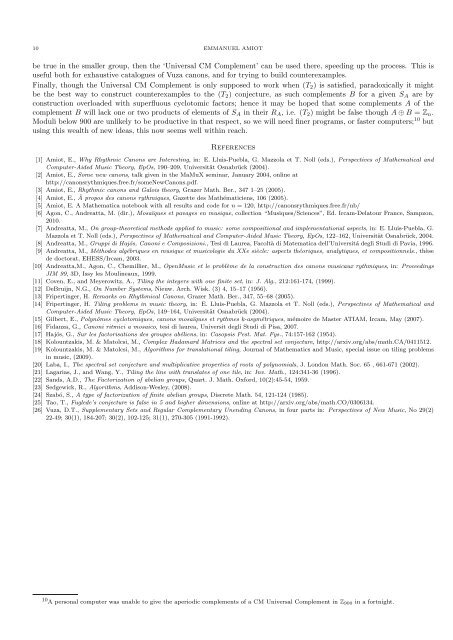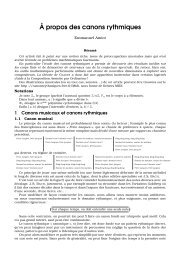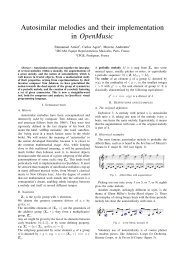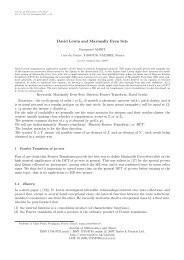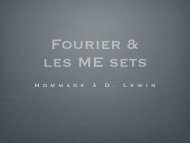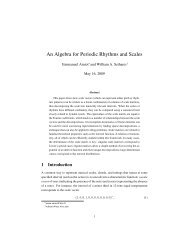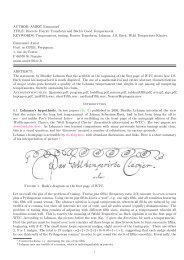Emmanuel Amiot Modèles algébriques et algorithmes pour la ...
Emmanuel Amiot Modèles algébriques et algorithmes pour la ...
Emmanuel Amiot Modèles algébriques et algorithmes pour la ...
You also want an ePaper? Increase the reach of your titles
YUMPU automatically turns print PDFs into web optimized ePapers that Google loves.
10 EMMANUEL AMIOT<br />
be true in the smaller group, then the ‘Universal CM Complement’ can be used there, speeding up the process. This is<br />
useful both for exhaustive catalogues of Vuza canons, and for trying to build counterexamples.<br />
Finally, though the Universal CM Complement is only supposed to work when (T2) is satisfied, paradoxically it might<br />
be the best way to construct counterexamples to the (T2) conjecture, as such complements B for a given SA are by<br />
construction overloaded with superfluous cyclotomic factors; hence it may be hoped that some complements A of the<br />
complement B will <strong>la</strong>ck one or two products of elements of SA in their RA, i.e. (T2) might be false though A ⊕ B = Zn.<br />
Moduli below 900 are unlikely to be productive in that respect, so we will need finer programs, or faster computers; 10 but<br />
using this wealth of new ideas, this now seems well within reach.<br />
References<br />
[1] <strong>Amiot</strong>, E., Why Rhythmic Canons are Interesting, in: E. Lluis-Pueb<strong>la</strong>, G. Mazzo<strong>la</strong> <strong>et</strong> T. Noll (eds.), Perspectives of Mathematical and<br />
Computer-Aided Music Theory, EpOs, 190–209, Universität Osnabrück (2004).<br />
[2] <strong>Amiot</strong>, E., Some new canons, talk given in the MaMuX seminar, January 2004, online at<br />
http://canonsrythmiques.free.fr/someNewCanons.pdf.<br />
[3] <strong>Amiot</strong>, E., Rhythmic canons and Galois theory, Grazer Math. Ber., 347 1–25 (2005).<br />
[4] <strong>Amiot</strong>, E., À propos des canons rythmiques, Gaz<strong>et</strong>te des Mathématiciens, 106 (2005).<br />
[5] <strong>Amiot</strong>, E. A Mathematica notebook with all results and code for n = 120, http://canonsrythmiques.free.fr/nb/<br />
[6] Agon, C., Andreatta, M. (dir.), Mosaïques <strong>et</strong> pavages en musique, collection “Musiques/Sciences”, Ed. Ircam-De<strong>la</strong>tour France, Sampzon,<br />
2010.<br />
[7] Andreatta, M., On group-theor<strong>et</strong>ical m<strong>et</strong>hods applied to music: some compositional and implementational aspects, in: E. Lluis-Pueb<strong>la</strong>, G.<br />
Mazzo<strong>la</strong> <strong>et</strong> T. Noll (eds.), Perspectives of Mathematical and Computer-Aided Music Theory, EpOs, 122–162, Universität Osnabrück, 2004.<br />
[8] Andreatta, M., Gruppi di Hajós, Canoni e Composizioni., Tesi di Laurea, Facoltà di Matematica dell’Universitá degli Studi di Pavia, 1996.<br />
[9] Andreatta, M., Méthodes <strong>algébriques</strong> en musique <strong>et</strong> musicologie du XXe siècle: aspects théoriques, analytiques, <strong>et</strong> compositionnels., thèse<br />
de doctorat, EHESS/Ircam, 2003.<br />
[10] Andreatta,M., Agon, C., Chemillier, M., OpenMusic <strong>et</strong> le problème de <strong>la</strong> construction des canons musicaux rythmiques, in: Proceedings<br />
JIM 99, 3D, Issy les Moulineaux, 1999.<br />
[11] Coven, E., and Meyerowitz, A., Tiling the integers with one finite s<strong>et</strong>, in: J. Alg., 212:161-174, (1999).<br />
[12] DeBruijn, N.G., On Number Systems, Nieuw. Arch. Wisk. (3) 4, 15–17 (1956).<br />
[13] Fripertinger, H. Remarks on Rhythmical Canons, Grazer Math. Ber., 347, 55–68 (2005).<br />
[14] Fripertinger, H. Tiling problems in music theory, in: E. Lluis-Pueb<strong>la</strong>, G. Mazzo<strong>la</strong> <strong>et</strong> T. Noll (eds.), Perspectives of Mathematical and<br />
Computer-Aided Music Theory, EpOs, 149–164, Universität Osnabrück (2004).<br />
[15] Gilbert, E., Polynômes cyclotomiques, canons mosaïques <strong>et</strong> rythmes k-asymétriques, mémoire de Master ATIAM, Ircam, May (2007).<br />
[16] Fidanza, G., Canoni ritmici a mosaico, tesi di <strong>la</strong>urea, Universit degli Studi di Pisa, 2007.<br />
[17] Hajós, G., Sur les factorisations des groupes abéliens, in: Casopsis Pest. Mat. Fys., 74:157-162 (1954).<br />
[18] Kolountzakis, M. & Matolcsi, M., Complex Hadamard Matrices and the spectral s<strong>et</strong> conjecture, http://arxiv.org/abs/math.CA/0411512.<br />
[19] Kolountzakis, M. & Matolcsi, M., Algorithms for trans<strong>la</strong>tional tiling, Journal of Mathematics and Music, special issue on tiling problems<br />
in music, (2009).<br />
[20] Laba, I., The spectral s<strong>et</strong> conjecture and multiplicative properties of roots of polynomials, J. London Math. Soc. 65 , 661-671 (2002).<br />
[21] Lagarias, J., and Wang, Y., Tiling the line with trans<strong>la</strong>tes of one tile, in: Inv. Math., 124:341-36 (1996).<br />
[22] Sands, A.D., The Factorization of abelian groups, Quart. J. Math. Oxford, 10(2):45-54, 1959.<br />
[23] Sedgewick, R., Algorithms, Addison-Wesley, (2008).<br />
[24] Szabó, S., A type of factorization of finite abelian groups, Discr<strong>et</strong>e Math. 54, 121-124 (1985).<br />
[25] Tao, T., Fuglede’s conjecture is false in 5 and higher dimensions, online at http://arxiv.org/abs/math.CO/0306134.<br />
[26] Vuza, D.T., Supplementary S<strong>et</strong>s and Regu<strong>la</strong>r Complementary Unending Canons, in four parts in: Perspectives of New Music, No 29(2)<br />
22-49; 30(1), 184-207; 30(2), 102-125; 31(1), 270-305 (1991-1992).<br />
10 A personal computer was unable to give the aperiodic complements of a CM Universal Complement in Z900 in a fortnight.


